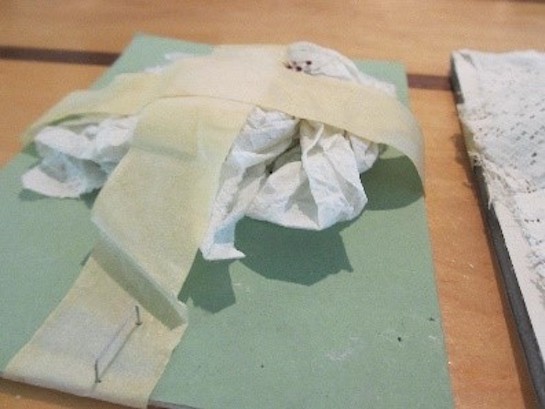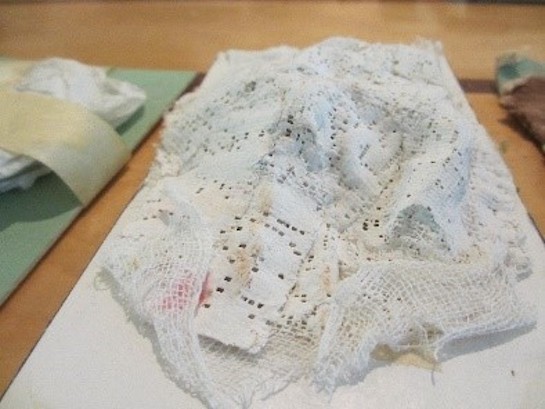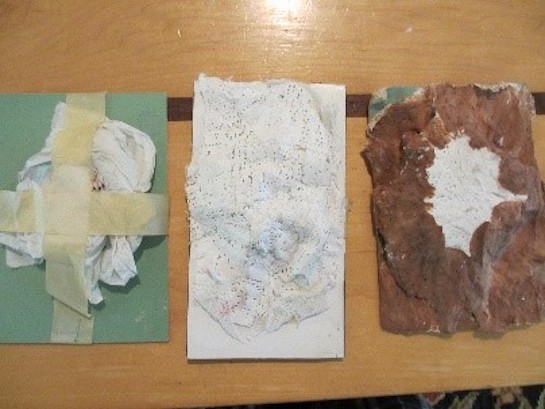Using plaster gauze strips, students will make an armature to create a 3-dimensional mountain sculpture. Recommended for 5th Graders.
Form: a 3-dimensional figure that exists in space. This project features organic form, in which the form is irregular and asymmetrical.
Space: can be positive: the space an object occupies or negative: the space around the object. It also refers to an illusion of depth on a 2-dimensional (height and width) surface, so that the scene appears to go back into space and real depth as used in sculpture.
Texture: actual texture is how something feels when touched; visual texture (also called simulated texture) is how something appears to feel.
Asymmetrical Balance: a form in which neither side is the same as the other but they still make a whole, with equally important sides.
3-dimensional: dimensions are a way of taking up space. All forms have height, width and depth.
Armature: a framework on which the sculpture is molded.
Base: the bottom of the sculpture which anchors it in space.
Craftsmanship: following directions and using care and neatness with tools.
Plaster gauze: open weave fabric infused with dry plaster. Useful for making molds.
Sculptor: someone who make sculpture.
Sculpture: a three-dimensional work of art.
Students will:
SCULPTING:



Lesson written by Cynthia Moring.
21st Century Thinking Skills
Observing, Making Connections, Visualizing, Sequencing, Determining Main Idea, Problem Solving, Determining Point of view, Decision Making, Evaluating
WA State Learning Standards
(VA:Cr2.1.5) a. Experiment and develop skills in multiple art-making techniques and approaches through practice.
(VA:Cr2.2.5) a. Demonstrate quality craftsmanship through care for and use of materials, tools, and equipment.
(VA:Cr3.1.5) a. Create artist statements using art vocabulary to describe personal choices in art-making. This happens when students use the vocabulary of the lesson.
(VA:Re7.1.5) a. Compare one's own interpretation of a work of art with the interpretation of others.
(VA:Re8.1.5) a. Interpret art by analyzing characteristics of form and structure, contextual information, subject matter, visual elements, and use of media to identify ideas and mood conveyed. This happens if students reflect on their work and the work of their peers.
(VA:Cn10.1.5) a. Apply formal and conceptual vocabularies of art and design to view surroundings in new ways through art-making.
Arts Integration Opportunities
Science: this lesson can be part of a geology lesson. If the armature includes a small plastic pill container centered at the ‘mountain peak’, it can hold baking soda and vinegar, to simulate volcanic eruptions.
Procedural Writing: Students describe how to build this sculpture, step-by-step.
Creative Writing: Students use the mountain range as a backdrop for a story.
Spelling: art vocabulary words can be included in spelling lists.
Music: plaster gauze over light bulbs will make maracas. Simply smack the finished sculpture hard enough to shatter the bulbs inside.
Group project: much larger mountains, or other objects can be made for stage sets.
Please note: These lesson plans are intended for non-profit use only. Use of these plans for commercial purposes should give attribution to the Issaquah Schools Foundation and be accompanied by a nominal donation at www.isfdn.org/donate. Thank you.
Fueling Success for Every Student, Every School